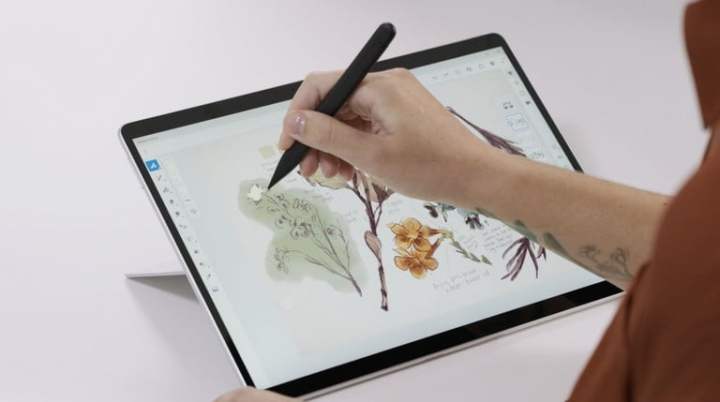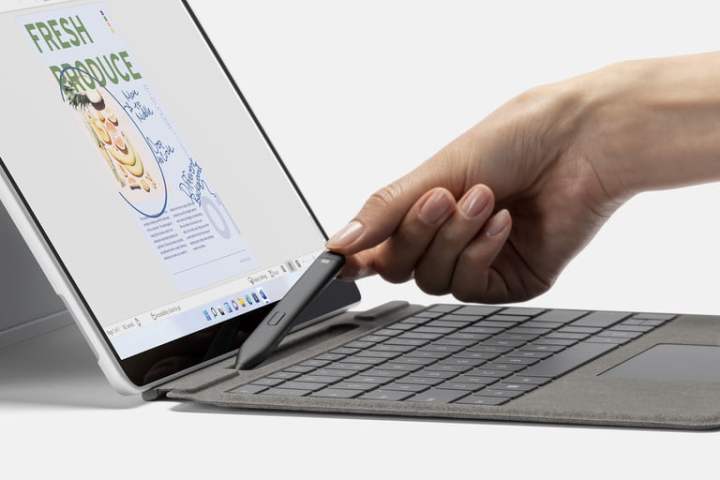Microsoft just announced the Surface Pro 8, and that means you might be wondering how it compares to last-generation Surface devices.
The Surface Pro 8 brings one of the biggest visual redesigns of a Surface in six years, yet it is not that very dissimilar from the Surface Pro 7 and Surface Pro 7+ in some other ways. We’re here to help you find the differences, and pick the Surface that’s right for you.
Price

Looking at just the price, the Surface Pro 8 is the most expensive Surface device in recent times. It starts at $1,099, without accounting for the Type Cover or the Surface Pen. On the other hand, the Surface Pro 7 is the cheapest device, starting at $749, and the Pro 7+ in between at $900.
At those prices, we’re looking at the base configurations. On the Pro 8, you’re getting Intel’s latest and greatest 11th generation Core i5 processor, alongside 8GB of RAM and a 128GB SSD. Storage is less important on the Pro 8 as you can always buy a bigger SSD and replace it later on — a feature carried over from the Pro 7+.
The base Pro 7, meanwhile, comes in with a slower 10th generation Core i3 processor, 4GB of RAM, and a 128GB SSD. Finally, the Pro 7+ comes with the 11th generation Core i3 processor, 8GB of
On all older Surface models, you can push the prices up by upgrading to a Core i7 or Core i5 processor or adding more RAM and storage. If you are on a budget and opt for an older Surface, we suggest the Pro 7+, as the base model comes with 8GB of
Performance

On the Surface Pro 8, Microsoft is no longer offering an entry-level model with a Core i3 processor. It jumped right to a mid-range Core i5, which delivers on Intel’s Ice Lake graphics advancements as well as Thunderbolt 4 support.
You can “upgrade” to get a Core i5 or Core i7 on the Pro 7 and Pro 7+, but it would kick the prices up to $900, and $1,000 and you’d still be missing out on Thunderbolt. For that reason, we can’t quite suggest buying the standard Pro 7 in 2021. It will be fine for most tasks, but it is now using Intel’s 10th-generation processors, which are 2 years old.
In fact, Microsoft mentioned that the Pro 8’s CPU is over 2 times faster than Surface Pro 7. It also can deliver over 40% higher sustained CPU performance and 74% faster graphics sustained performance.
On the Surface Pro 7+, meanwhile, you’ll be getting a generation newer 11th generation processor for the money, making your device more future-proof. It also has the same processor as found in Pro 8. We still suggest the Pro 8, however, since it is newer and the Pro 7+ is becoming harder to buy and find at the Microsoft Store.
But there’s another important fact, too. The Surface Pro 8 has support for Thunderbolt technology. This is an exclusive feature to the Surface Pro 8 and the Surface Laptop Studio. If you need to use an external GPU or hook up your Surface to dual monitors and want faster transfer speeds, then this is the Surface for you.
Design & accessories

Between the three devices, the Pro 8 has the newest design. Like the Surface Pro X, Microsoft has switched up the design on this year’s Pro 8. The new device is still very slim, light, and is still made out of anodized aluminum like its other cousins, but the front of the Pro 8 looks a bit different with slimmer bezels. Microsoft says that the Pro 8 is 11% larger than the Pro 7.
Indeed it is true, as the Pro 8 has a new 13-inch screen. That’s a change from the Surface Pro 7 and Surface Pro 7+, which only come in with a 12.3-inch panel. Yet despite the big screen, thickness and weight have barely changed between generations. All the devices are under 3 pounds, and less than half an inch thick.
Of course, the accessories for the Pro 8 changed with that slimmer screen. Now, the Surface Signature Type Cover on the Pro 8 has a slot for the new Surface Slim Pen 2. This lets you recharge the pen while it is not in use. Previously on the Surface Pro 7 and Pro 7+, you’d need to use an external charging cradle for the Slim Pen, or opt for a standard Surface Pen, which is attached to the side and worked with AAAA batteries.
Importantly, the Slim Pen 2 also has haptic engines in it, so you can get feedback from the Pro 8 as you slide it across the screen. We have more on that later, as this is an exclusive feature to the new Pro 8.
Display

The bigger display on the Pro 8 also means some improved specs and room for some exclusive special haptics powered by Windows 11. The resolution on the Pro 8’s display gets bumped up a bit when compared to the Pro 7 and Pro 7+.
On the Pro 8, you’re getting a display with 2880 x 1920 resolution, and 267 pixels per inch. On the Pro 7 and Pro 7+, things maxed out at 2736 x 1824. Pixels per inch are still the same, but there’s now a bit more room for multitasking on the Pro 8.
In addition to that, the Surface Pro 8 has its own support for haptics via the Surface Pen 2. It even has a 120 Hz refresh rate. This is thanks to the Microsoft G6 processor onboard which can pick up “tactile signals.” Video and photo editing, as well as gaming and inking, should feel more smooth and natural on the Pro 8 when compared to the Pro 7 or Pro 7+, so if this is what you’re after, the Pro 8 is for you.
Portability

We will end by mentioning portability. On this front, we account for battery life, cameras, as well as ports. It’s pretty much an even matchup here with a few exceptions.
The Surface Pro 8 has dual USB-C Thunderbolt 4 ports, as well as a Surface Connect Port, and a headphone jack. There is no expandable storage or USB-A port, so you’ll need to dongle up. The Pro 7+ has a USB-C port, a USB-A port, a 3.5 mm headphone jack, a Surface Connect Port, and a MicroSD card reader. That’s just like the Pro 7, which makes it a good option if you don’t want to use a dongle.
When it comes to webcams, the Pro 8 has been updated big time. The webcams are now 1080p, a change from the 720p on the Pro 7 and Pro 7+. This should make you look better on your calls.
Finally, there’s battery life. The Pro 8 wins on this front, as it is rated for up to 16 hours. The Pro 7, meanwhile, gets 10 hours, and the Pro 7+, 13.5 hours.
The Surface Pro 8 wins over everything else here for longer battery, Thunderbolt support, as well as improved webcams.
Surface Pro 8 wins
We don’t have one yet, but we can’t but help to suggest the Surface Pro 8 for anyone looking for a new Surface. The device is much more modern, comes with Thunderbolt 4 support, a bigger display, and support for haptics with a new Surface Pen.
Unless, of course, you’re on a tight budget. The $300 increase in price makes it a far more premium device, especially once you add in the keyboard and stylus. In that case, the Surface Pro 7+ is a good alternative. At this point, the Surface Pro 7, though, is a bit too outdated to get a recommendation at this point.
Editors' Recommendations
- Surface Pro 10: all the major changes rumored for the new model
- MacBook Pro 16 vs. MacBook Pro 14: The important differences
- Gemini Advanced vs. Copilot Pro: which is the better deal?
- The Surface Pro 10 sounds amazing, and it may be coming soon
- All the apps that will be available for the Vision Pro


